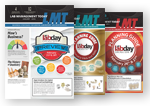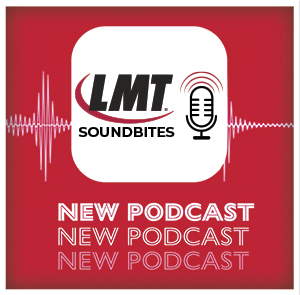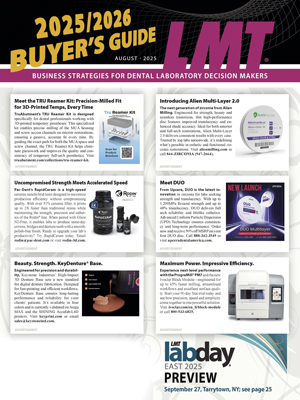Step 1:
The panograph image shows bone loss on the maxilla and mandible from pre-molar to pre-molar with opposing edentulous areas distal to second pre-molar. To fabricate the immediate digital dentures, Dr. Melton took impressions, scanned them to create .STL files and sent them to AvaDent for design via AvaDent Connect software.Step 2:
The remaining dentition in the digital file (.stl) was virtually extracted and ridges reduced to match what Dr. Melton would do in the mouth.
AvaDent created a design preview and sent it to Dr. Melton so he could evaluate the anterior esthetics and posterior functional occlusion in relation to existing terminal dentition references such as incisal edge position, midline, arch form and inter-residual ridge relationship.
After the design was approved, the file was exported for programming, puck selection and milling at AvaDent. The immediate digital dentures were finished and polished.Step 3:
After the terminal dentition was extracted, the immediate denture was delivered; note the anterior teeth were digitally arranged with minimal overjet and overbite, eliminating anterior guidance and lateral interferences in excursive movements.
After the patient healed, Dr. Melton did a tissue-conditioning reline on the immediate dentures to capture resorbed tissues and ridges.Step 4:
To proceed with the BTI, Dr. Melton took an occlusal check bite record that was scanned along with the immediate denture, creating three .STL design files: maxillary and mandibular reference dentures and occlusal record bite; all files were sent to AvaDent.
AvaDent created a design file (pictured above) for the BTI and Dr. Melton approved it. The BTI was milled from a tooth-shade puck, finished and polished by AvaDent technicians and returned to Dr. Melton’s laboratory to verify relationship records and anterior esthetics.Step 5:
At the try-in appointment, Dr. Melton verified the fit, function, stability, phonetics and prosthetic space, and the patient was able to take the try-in home to check esthetics and function during mastication.
After he approved the BTI, a new check bite record was taken to verify desired maxillo-mandibular relationship, thus establishing the vertical dimension and prosthetic space.Step 10:
Dr. Melton tried in the double structure Snap-pin fixed-detachable bar system, which was designed and milled by Supra Solutions. (This bar try-in appointment is up to the discretion of the clinician; other options for this appointment include try-in with teeth or going right to the final delivery of implant overdentures.)Step 12:
The overdentures were scanned to generate a color map for verification of milled tooth and base surfaces; the color map was used as a quality control tool by the AvaDent finishing technician. The green verifies the teeth and base are in the proper position after milling, red means the area is displaced further (positive position) than the original digital denture design, and the blue means the area is displaced in an opposite position in relation to the digital design.Final Result:
The final fully milled digital maxillary fixed detachable implant-supported prosthesis and mandibular implant-retained digital overdenture exceeded the patient’s esthetic and functional expectations.
The .STL files are retained by AvaDent, eliminating the need for new impressions and records in case the implant prosthesis is lost or the patient wants to have a duplicate digital overdenture made.
Contact Information: Call 855-282-3368 or visit www.avadent.com.






























